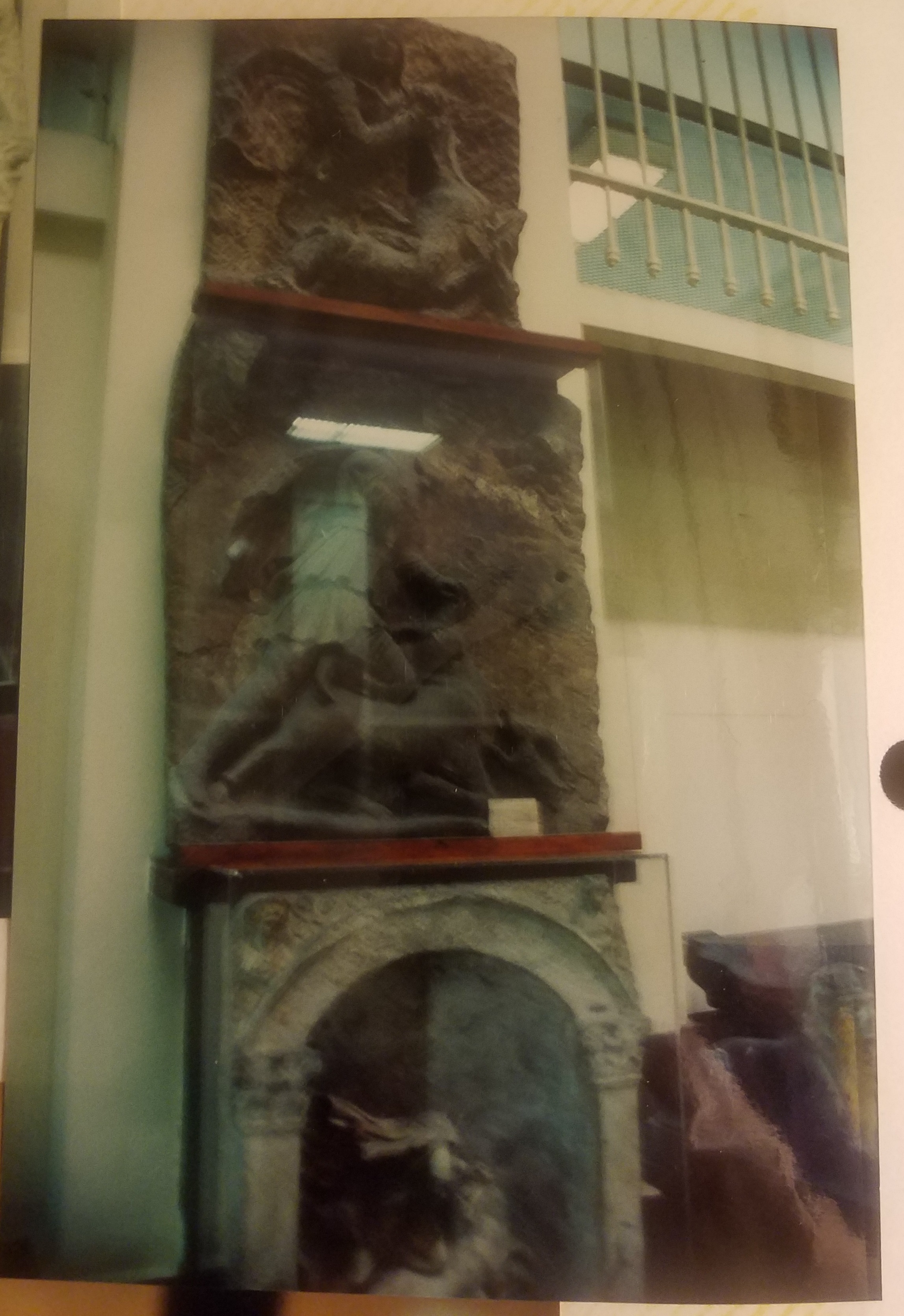
CIMRM 91, 92 and 93 - Tauroctonies from Hermopolis and Memphis, Egypt.


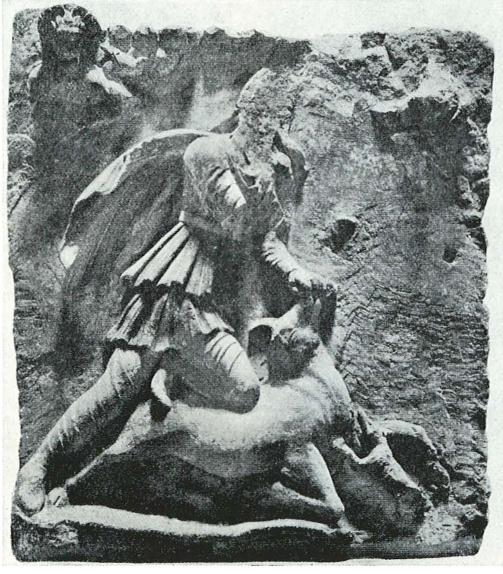

Four reliefs of the tauroctony are known from Egypt. Three are all displayed together in the Cairo museum, the fourth is in Berlin.
CIMRM 91 (JE 85747) is a marble relief of a tauroctony discovered, not at Memphis in 1885 as Vermaseren says, but at Hermopolis (al-Ashmunein) and sent to Cairo in 1941 by the inspector at Asyut.1 The mistake arises because the three were grouped together at the Cairo museum, and appears elsewhere in the literature. The photo given as fig. 34 in Vermaseren in fact relates to CIMRM 92.
Günter Grimm: Kunst der Ptolemäer- und Römerzeit im Ägyptischen Museum Kairo. Pp. 34; 118 plates, 5 in colour, 1 map. Mainz (1975) (11, 23 no 38, pl.73)
An additional tauroctony, probably from Hermopolis, is described by Harris:
The second piece (fig. 3) is a limestone relief (h. c.18 cm) obtained by the Berlin Museum in 1895 through Dr. Carl Reinhardt,(2l) who it is known had material found at Hermopolis. The little relief, of Mithras slaying the bull, is roughly shaped and of summary execution, and may have been meant to be plastered into a wall, although it is not impossible that it was some sort of preliminary sketch. Whether or not this piece and the roundel are actually from Hermopolis, the Cairo relief alone is adequate evidence for the cult, which the fragmentary codex recently published as a mithraic catechism would seem to suggest was still flourishing in the 4th c.
(21) Inv. no. 12639 (now lost?): Königliche Museen zu Berlin, Ausführliches Verzeichnis der Aegyptischen Altertümer und Gipsabgüsse (2nd ed., Berlin 1899) 331. I owe the photograph to the Staatliche Museen zu Berlin (E). W. Schubart, Einführung in die Papyruskunde (Berlin 1918) 353: "Darstellung und Weihung auf einem Steine des Berl. Museums" refers to a piece from Egypt which cannot be this, but might be the Rubensohn fragment, if for the Berlin Museum one understands a collection in Berlin.
CIMRM 92 and 93 come from Memphis. In 1885 Grebaut discovered some Mithraic finds at Memphis. No proper excavation was done, nor was any report made. The two finds have become confused by arriving at the Cairo museum at the same time.2
Cumont lists the two Memphis tauroctonies, and gives photographs of both, made by Emile Brugsch, the museum director at the time, which allows us to discover Vermaseren's mistake. There is no indication that Cumont had seen the items.
Cumont states, apparently from the photographs (supplied by Emile Brugsch), that the quality of the sculpture, and its preservation, is much worse than that from Hermopolis (CIMRM 91).3
CIMRM entry
MEMPHIS
91.
At about a mile's distance from the village of Mit-Rahine near Memphis a Mithraeum has been discovered, which itself has not yet been described. The finds have beeu transported to the Museum of Cairo.
Marble relief (H. 0.92 Br. 0.69). Inv. No. 85747.
Virey, Gizeh, 95 No. 296 and 296bis; MMM II 407 and 520ff No. 285 with fig.; Wiedemann in Wiener Zeitschr.f. die Kunde des Morgenlandes XXXI, 1924, 310f; Maspero, Guide Caire, 219 No. 990; J. Strzygowsky, Catalogue general du Musee de Caire4, s.d., 9ff with fig. (see fig. 34).
Mithras in ochreous tunic and red cloak as bull-killer. Snake creeping over the ground, dog near the wound; scorpion on the usual place. The background is rocky; in it on the left side the raven and in the middle above Mithras' head a bust, coming out of the rock (Saturn). On either side of this main scene a column with capitals of foliage, supporting the arch of the grotto. On these columns Cautes(r) and Cautopates(l) are represented, holding with both hands their torches. They do not stand cross-legged. In the upper corners, outside the niche, the busts of Sol in nimbus and radiate crown and of Luna in a crescent. This part of the relief has been richly adorned with leafy branches.
Lost: head and r. arm with dagger of Mithras; the rear quarter of the dog and the lower part of Cautes.
92.
Relief in limestone (H. 0.87 Br. 0.80). Inv. No. 7259.
MMM II No. 285b and fig. 479.5
In a cave Mithras, killing a very small bull. The god, whose r. arm and head have got lost, wears a Phrygian cap with two long flaps hanging over his shoulders. On the border of the rock the raven; the dog and snake are present; whether the scorpion had been represented is not clearly to be seen. In the upper corners the busts of Sol(l) in nimbus and radiate crown and of Luna in crescent(r). On the border of the rock traces of red paint.
93.
Relief in limestone (H. 0.85 Br. 0.70). Inv. No. 7260.
MMM II No. 285c and fig. 480.
The badly preserved and primitive relief represents Mithras in Eastern attire as a bull-killer. The dog, snake and scorpion are present; the raven is no longer visible. In the upper corners the busts of Sol and Luna had presumably been represented.
Bibliography
- J.R. Harris, "Mithras at Hermopolis and Memphis", in: Donald M. Bailey (ed.) Archeological research in Egypt: The Proceedings of The Seventeenth Classical Colloquium of The Department of Greek and Roman Antiquities, British Museum, held on 1-4 December, 1993, Ann Arbor (1996), p.169-176.
| 1 | Harris, p.169. |
| 2 | J.R. Harris, "Mithras at Hermopolis and Memphis", in: Donald M. Bailey (ed.) Archeological research in Egypt: The Proceedings of The Seventeenth Classical Colloquium of The Department of Greek and Roman Antiquities, British Museum, held on 1-4 December, 1993, Ann Arbor (1996), p.169-176. |
| 3 | TMMM, vol. 2, p.520, para. c. |
| 4 | Josef Strzygowski, Koptische Kunst, Vienne, 1904. XXIV, 362 pp., 40 pls. Online at Archive.org. Via AWOL; US only at Google Books here. |
| 5 | This appears to be a mistake by Vermaseren. p.285b and fig. 479 are the relief described in CIMRM 91. The actual reference is 285c and fig. 480. These V. has treated as CIMRM 93. |
| Tweet |
